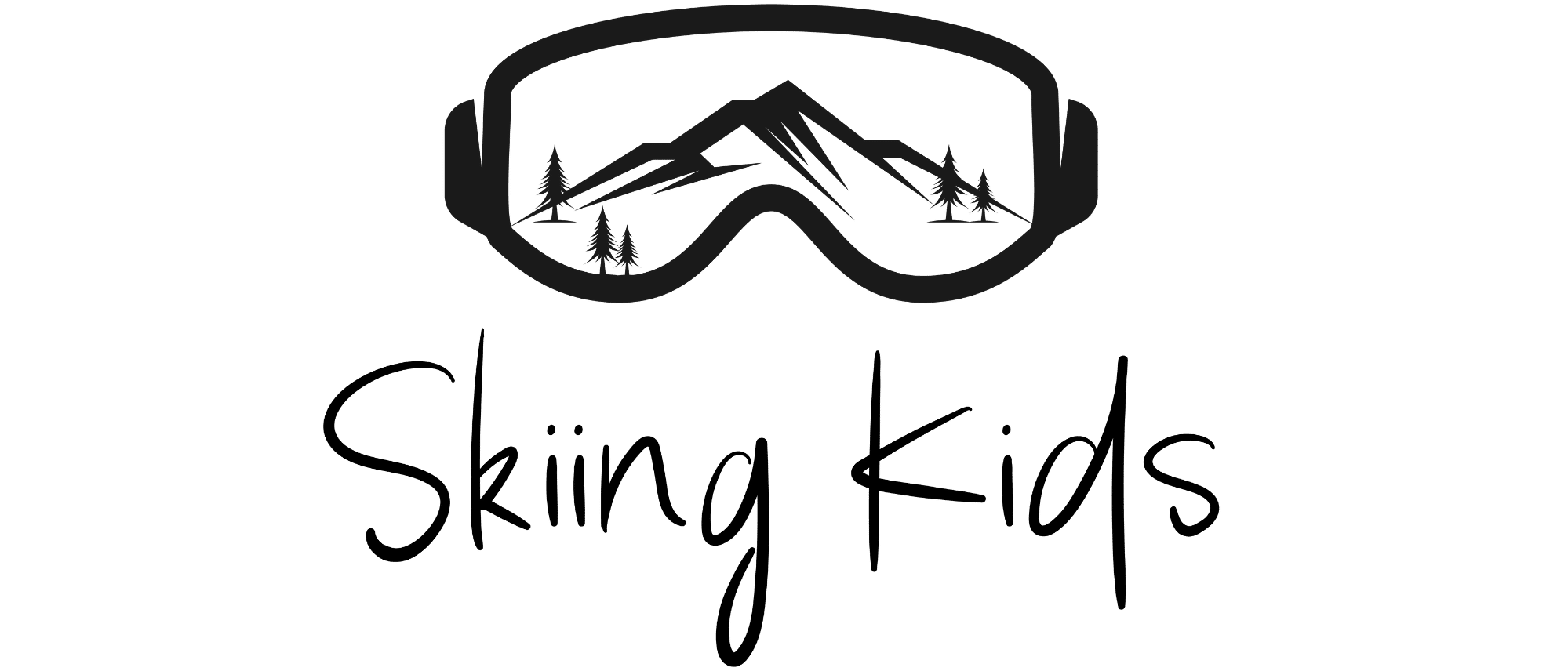This post may contain affiliate links where we earn from qualifying purchases from referring you to our favorite products and brands. As an amazon associate, we earn from qualifying purchases. Find out more in our disclosure.
In the last 5 years, the sport of skiing has exploded in popularity and the number of skier visits has increased drastically. While we love seeing more people on the mountain, this isn’t always a good thing for all the other skiers on the mountain. This increase is bringing more crowds and many of them have less experience, which can create some problems and more accidents.
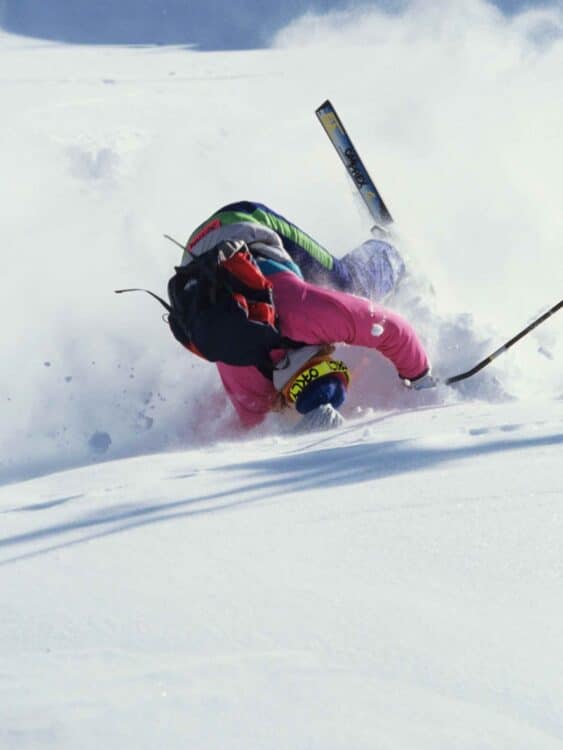
In the last 5 years, I’ve been hit on the mountain more times than I can count. Most of those were a small hit to my skis that just made me lose my balance, but others knocked me over hard. Almost every one of these occurred while skiing behind my kids in crowded terrain, and if they had gotten any of those hits, they would have been hurt pretty bad.
Read: How to ski safely in a crowd
While I would love to hover behind each of my kids to make sure that no one crashes into them, the reality is that with 5 kids ranging from age 6-16, it’s not possible or even necessary. Instead of being the ski helicopter mom, we’re teaching our kids all about defensive skiing so they can protect themselves from hazards as much as possible on the ski hill. Below, I’ll be outlining what we’re doing to teach our kids to be defensive skiers and riders, but these tips can be applied to all ages, not just kids.
Why Learn Defensive Skiing?
When we talk about defensive skiing with our kids, we do our best to not make skiing sound dangerous or scary. However, our kids have had enough accidents and near misses to know that caution is necessary. This was driven home when a few weeks ago, my 6-year-old fell on an uncrowded intermediate run. As he was getting up just a few seconds later, a snowboarder came barreling down the mountain riding at least 40MPH and came within inches of hitting my son who was in plain view (with neon clothing on). Had he hit him, I’m certain he would have been in critical condition or worse. It was a good wake up call for everyone that we need to be extra cautious and look out for each other on the mountain.
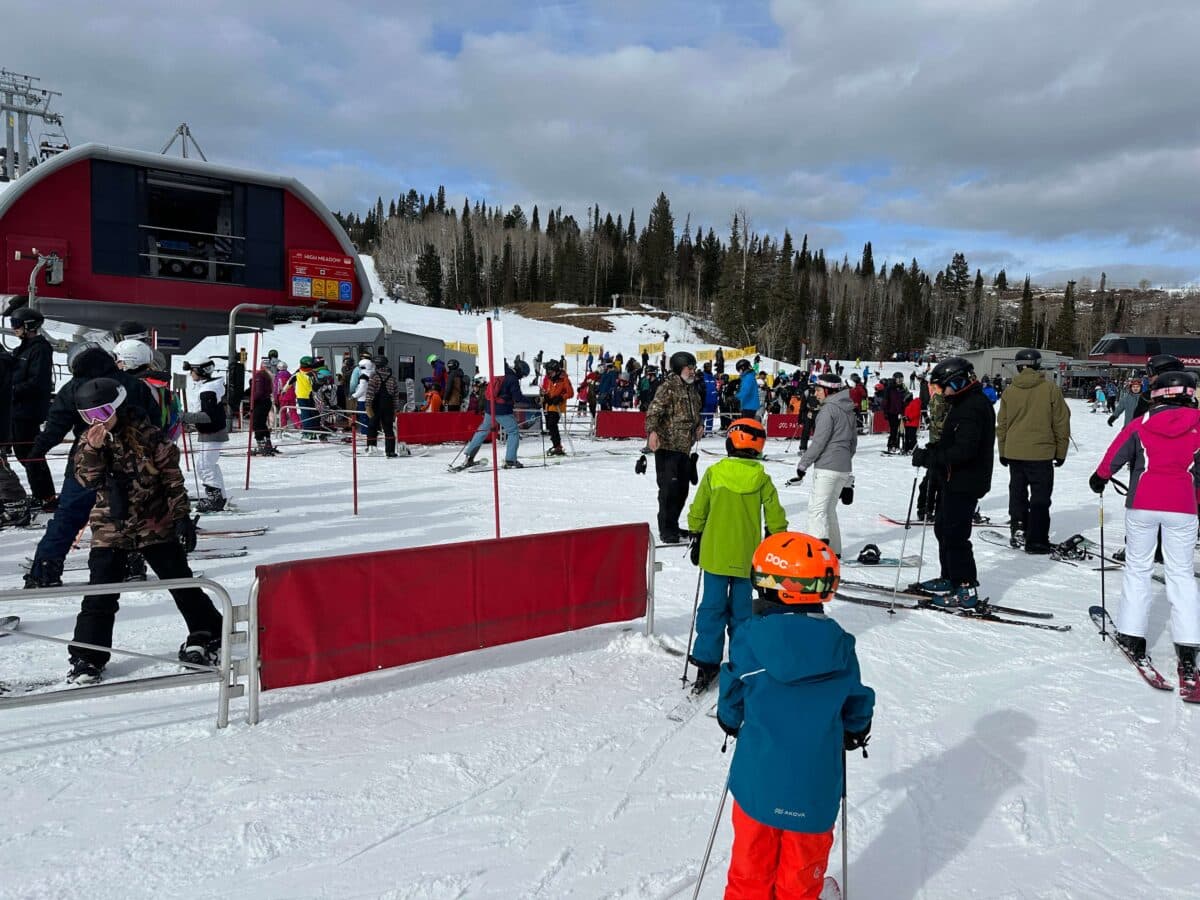
Here’s how we phrase it for our kids on crowded days:
“Hey guys, there’s a holiday this week and a lot of people came from out of town to ski. Just like you, they’re all REALLY EXCITED to be out here today. And just like you, when they get excited, they want to ski fast. But, a lot of these people only ski a few days a year, so they might not be very good. So if you see someone who looks lost or confused or who looks out of control, make sure you’re still nice to them, but don’t ski near them. Remember if you ski fast, but you’re not very good, it’s dangerous for other skiers on the mountain”.
We don’t make a big deal of it, but we do lay it out there for them to know the facts.
Learn to Identify Out of Control Skiers and Riders
In most areas of life, we’re teaching our kids not to be judgemental, but this is an area where we judge pretty hard. We want our kids to err on the side of caution, so we point out very clearly what makes a skier who’s in control and one who’s out of control.
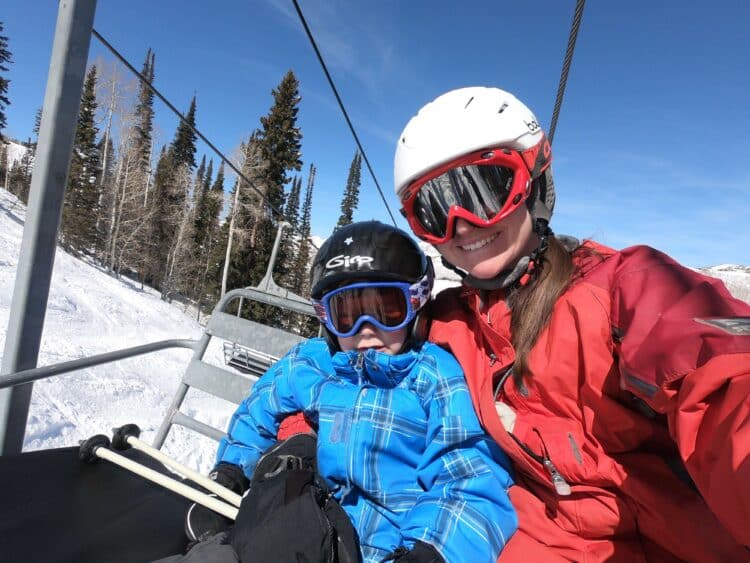
We start by doing this on the chairlift where we have a good aerial view. I’ll point out the good things that skiers and riders below us are doing so that my kids can know what a GOOD example looks like. Then after doing that for a run or two, we’ll start identifying bad skiers and riders. Here are some things that we point out that make a skier or snowboarder dangerous to ski around:
- They go too fast in areas that are for beginners or intermediate levels OR when there are crowds
- They don’t stop in control.
- They ski too close to other skiers
- They go straight down the mountain.
- Someone who doesn’t turn predictably (maybe one giant turn and three short turns followed by a medium turn).
Now most of these “dangers” are phases of skiing that everyone goes through especially as they’re learning, so they’re not BAD people, they can create dangerous ski situations for kids to be around so we avoid them on the hill. As a great side effect of doing this practice with our kids, it’s really easy for us to casually point out when THEY’RE doing something that could be dangerous for others.
NOTE: We only do this a few runs a day or when there’s something super dangerous that we see below. Most of our chairlift rides are playing games, joking, and eating treats!
Stop Where You’re Clearly Visible and Out of the Way
This is part of the skier’s responsibility code, but most people don’t clearly understand what it means. It means that you should stop off to the side of the run, and at the TOP of the hill. I regularly see people stopping just below the hill, which makes it nearly impossible for skiers and riders to see them as they’re coming down the trail. If you stop somewhere that you can’t see uphill skiers, there’s a big chance someone will come over that hill and run right into you!
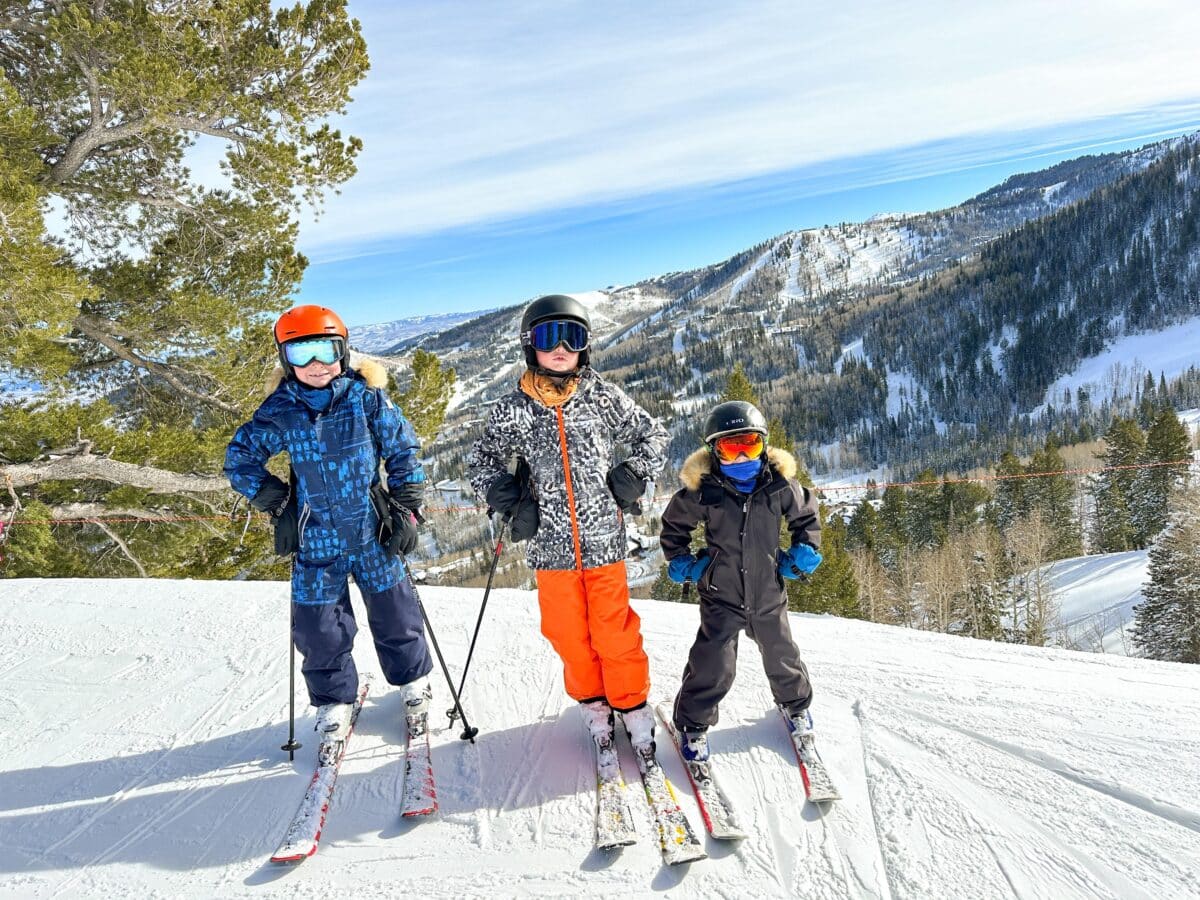
Listen Closely For Dangers
Have you ever heard the chatter of a snowboard or ski edge right behind you? That’s what we have our kids listen for. We don’t let our kids ski with headphones and we want them to be aware when someone’s getting too close to them. Often you’ll hear the chatter of someone trying to unsuccessfully stop, and if you’re aware, a quick shift in your direction can prevent someone from crashing into you when they’re sliding out of control.
We also have had plenty of times where someone is sliding down the mountain and can’t stop and they yell at us to move. We’re so grateful for those warnings, so we make sure our kids know to move quickly when someone shouts at them and to think after they move.

Give Others Plenty of Space
We have our kids space out about 3 seconds worth of time whenever our family starts skiing (1-2 seconds for the younger/slower kids). This usually gives us plenty of space between skiers and allows everyone to have a safe area around them to stop and turn.
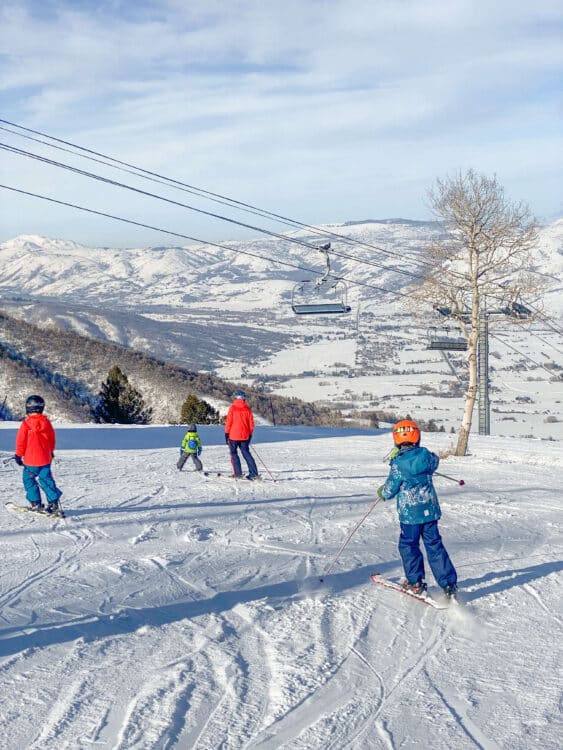
When we’re skiing in crowds, we tell our kids to give other people that same amount of space when they can. Our rule of thumb is that you shouldn’t be skiing closer than you can stop. If the person in front of you were to fall down right now, and you can stop before you get to them, that’s a good distance. In crowded areas, there just isn’t as much space, so we have everyone slow down their speed when they can’t give as much physical space.
As a general rule, on crowded runs, we always have our family ski near each other and we all pick one side to ski down, since the sides are generally less crowded than the middle of the run.
Wear Bright Clothing
For younger skiers or beginners who might not be as skilled, one of the best things that you can do to practice defensive skiing is wearing bright clothing. While one my my boys prefers another helmet for warmth, on crowded days, we have both of our younger kids wear neon orange helmets. This makes them extra visible to other skiers and riders. Additionally, we always try to dress our kids in bright clothes. This makes it easy for us to keep trak of them and easier for others to be aware of them. Our favorite bright ski clothes for kids are from Akova and Reima.
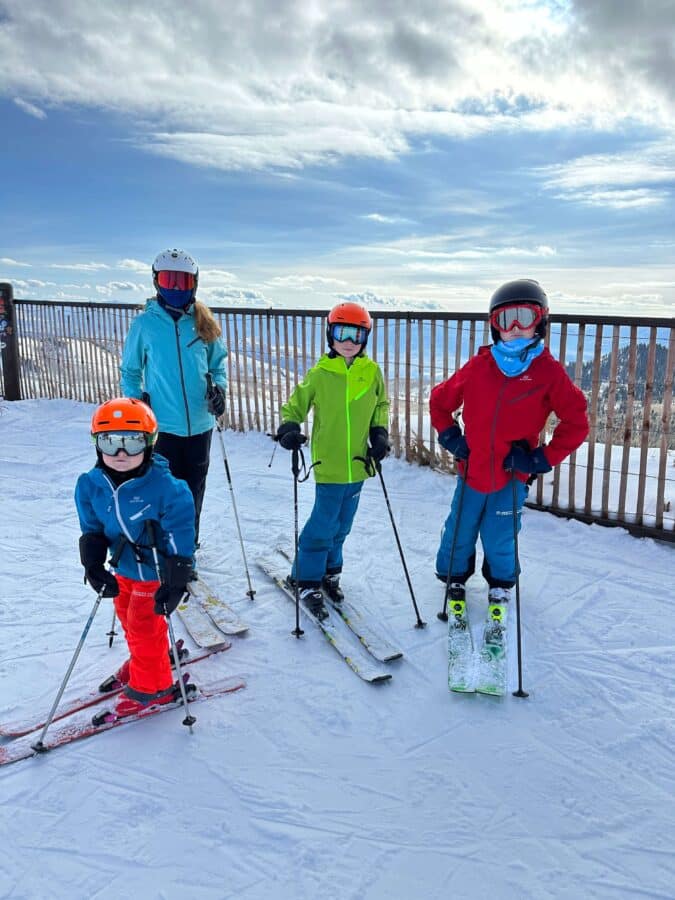
Have an Adult Ski Behind Young Kids
While I can’t ski behind ALL of my kids, when it’s crowded, we always have someone shadow our youngest, usually myself or my husband. If I need to take the lead, I’ll have one of my teens ski behind their little brother. All of our kids are pretty solid skiers, so our 6-year-old doesn’t need to follow anyone to learn how to turn or get down the mountain. My teens have had their skis clipped from behind a couple of times while doing this and they were both grateful that their tiny brother wasn’t the one hit, since they bounced right back, but it would have taken him out pretty hard.

Always Yield When Trails Merge
As part of the skiers responsibility code, the uphill skier has the right of way. But what about when 2 trails merge? In our family, we have a rule that we ALWAYS YIELD! If we always yield to other skiers, we’re generally much safer at intersections. To help make this easier, whenever there’s a junction, our kids know that they stop and wait to make sure everyone’s going the right way. While a merging trail is different than a junction, they almost always stop and wait at trail mergers too!
Verbally Call Out Hazards for Others
In our family, no one skis alone, everyone always has at least 1 buddy. REgardless of who’s older, everyone looks out for each other. We naturally call out hazards for our kids while skiing, and now they’ve learned to do that for others too. Here are some ways that they call out hazards “Rock” “Watch out for the ice” “Careful it’s slushy”. However, they most important way to call out a hazard is if there’s a skier who fell who isn’t visible to others. This happens often in the terrain park. If someone falls, my kids know to shout out “skier down” to everyone coming down until the person who fell has moved to safety.
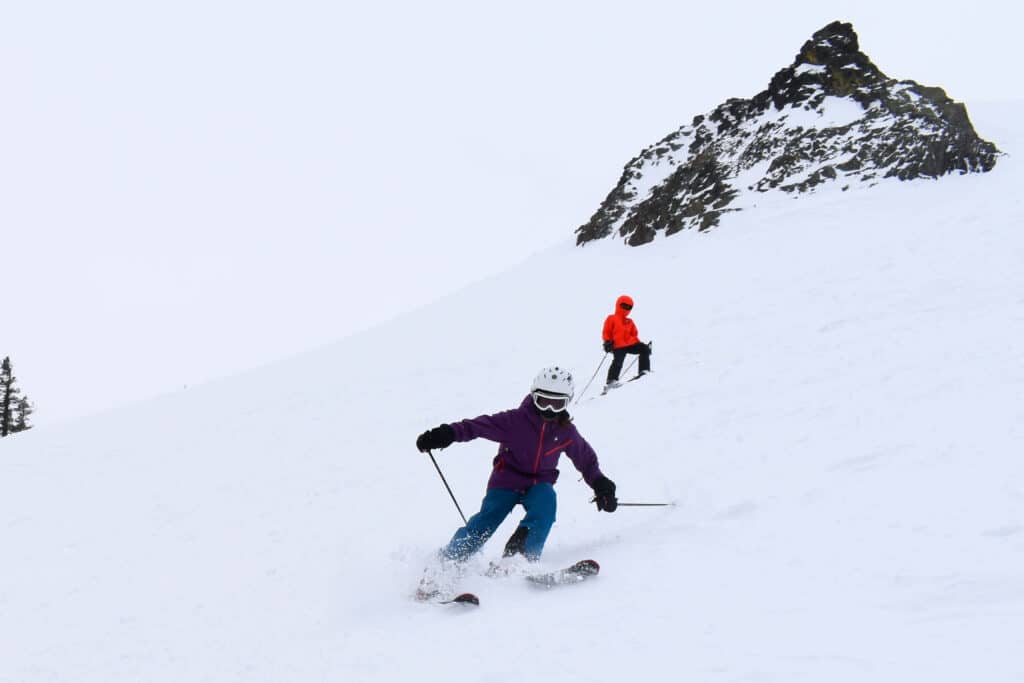
On that note, it’s also important when skiing bigger terrain parks to keep a close eye on less experienced skiers, especially on big jumps. At our local hill in Park City, we recently saw a younger kid go off a big tabletop and crash on the backside where not one could see them. The takeoff for the jump was high above the hill and the rider behind them almost landed on them, despite us yellign a warning. Clearly this younger skiers, shouldn’t have been on this area, especially knowing that the advanced riders go FAST and BIG off those jumps. On crowded days especially, kids need to be extra cautious in the terrain park to avoid problems like this.
Ski Within Your Ability
I just touched on this in the last paragraph, but one of the best ways to keep yourself safe is to know your limits and stay in them. Just because you can get down that black diamond (eventually) might not mean that you’re ready to ski it. This applies to both the terrain that you choose and the speed you choose to ski at. Know your level and try to stay close to that.
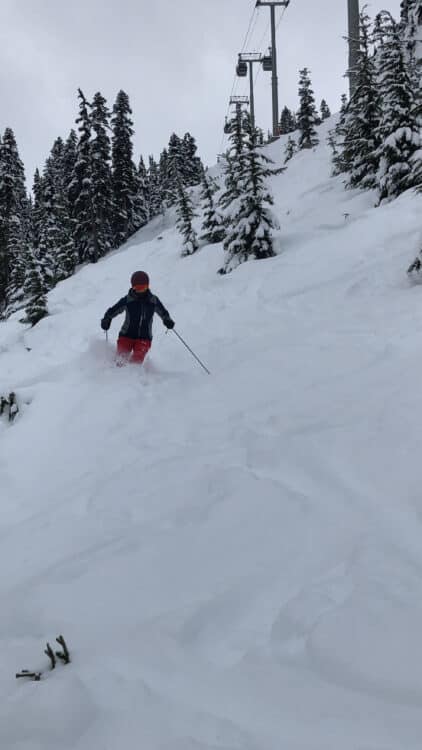
Over the recent holiday break at Park City, there was an area marked “advanced terrain only.” From the top, it didn’t look difficult, but as you got down the mountain it was. Eventually, everything funneled into a super icy and steep black diamond run. I saw at least 20 people during the course of one day sliding down it on their butts because they had gotten into terrain that was too hard for them. Not only was this probably uncomfortable for them, but it puts them at a major risk of getting hit by other skiers and riders who are trying to get down the mountain.
Learn Where It’s Safe to Ski Fast and Where It’s Not
On nearly every mountain, there are sections of beginner terrain that everyone has to ski through to get to the bottom of the mountain. Once our kids are past the beginner phase, we have them avoid those areas, and when we do ski there, we quickly regroup before entering the learning area. I’ll give them all a quick reminder that goes something like this:
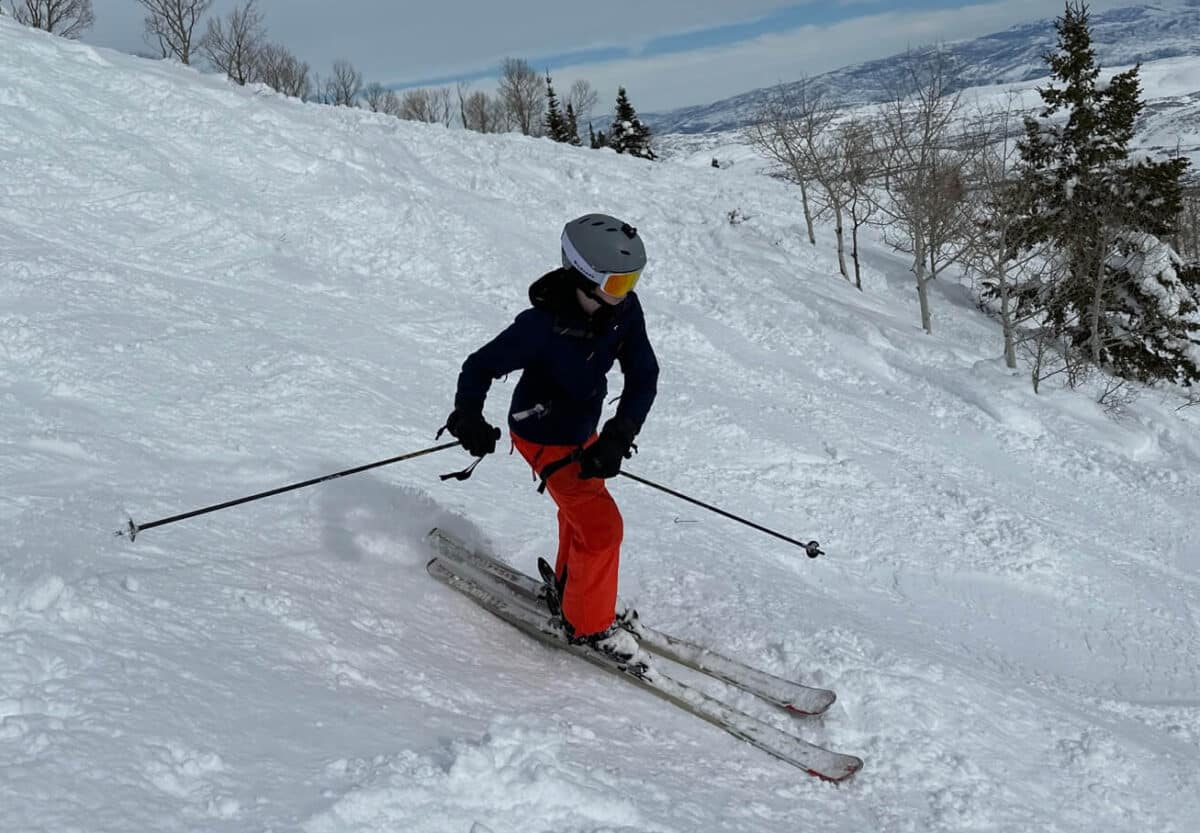
“Hey kids, we’re about to ski down the bunny hill. A lot of these people are super excited to ski, but they aren’t very good yet. Do what you can to make learning easier for them. Give them lots of space since they’re still learning to turn and when people learn to ski, they often fall. You can have fun, but this isn’t a place to ski fast. Remember, you’ve been skiing since you were really little, so you need to be the one to keep the ski hill safe, even if you’re skiing by grown ups. Watch out for them and if someone falls down, remember to check and see if they’re okay or need help.” We do this for our kids until they’re about 8-9 when they start to roll their eyes at my pep talk, but really know what they’re supposed to do.
Stay Together As A Group
The saying of safety in numbers is especially true on the ski hill. We have a rule that no one ever skis alone. While we have a HUGE variety of ages and speeds just within our family, we all still wait. We have designated waiting points on the runs that we ski often and on new runs, we usually just point to a spot far down the hill and have everyone wait there. This way if someone has a problem, we all know and can help out. It also means that we can form our own little bubble of people in the crowd to help hover over our beginner skiers to keep them safer. While we don’t always ski together as a family of 7 (we often split up 3 & 4), we usually have friends with us too, to it’s a rare day when we’re skiing with less than a group of 6! Staying together is our #1 non-negotiable rule for skiing in our family!

While I’d love to say that there’s a magic cure for avoiding all ski collisions from other people, there just isn’t, but skiing defensively can help a lot. By practicing defensive skiing, you’re removing as much of the risk of others hitting you as you possibly can so you can safely enjoy your ski day!
